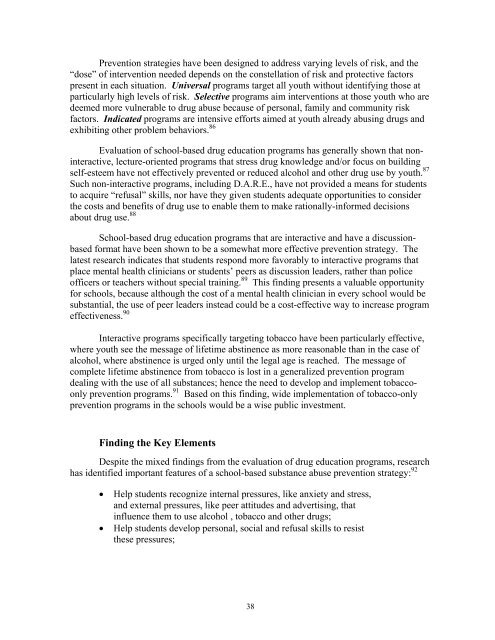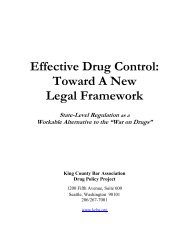Is It Time to End the War on Drugs? - King County Bar Association
Is It Time to End the War on Drugs? - King County Bar Association
Is It Time to End the War on Drugs? - King County Bar Association
You also want an ePaper? Increase the reach of your titles
YUMPU automatically turns print PDFs into web optimized ePapers that Google loves.
Preventi<strong>on</strong> strategies have been designed <str<strong>on</strong>g>to</str<strong>on</strong>g> address varying levels of risk, and <str<strong>on</strong>g>the</str<strong>on</strong>g>“dose” of interventi<strong>on</strong> needed depends <strong>on</strong> <str<strong>on</strong>g>the</str<strong>on</strong>g> c<strong>on</strong>stellati<strong>on</strong> of risk and protective fac<str<strong>on</strong>g>to</str<strong>on</strong>g>rspresent in each situati<strong>on</strong>. Universal programs target all youth without identifying those atparticularly high levels of risk. Selective programs aim interventi<strong>on</strong>s at those youth who aredeemed more vulnerable <str<strong>on</strong>g>to</str<strong>on</strong>g> drug abuse because of pers<strong>on</strong>al, family and community riskfac<str<strong>on</strong>g>to</str<strong>on</strong>g>rs. Indicated programs are intensive efforts aimed at youth already abusing drugs andexhibiting o<str<strong>on</strong>g>the</str<strong>on</strong>g>r problem behaviors. 86Evaluati<strong>on</strong> of school-based drug educati<strong>on</strong> programs has generally shown that n<strong>on</strong>interactive,lecture-oriented programs that stress drug knowledge and/or focus <strong>on</strong> buildingself-esteem have not effectively prevented or reduced alcohol and o<str<strong>on</strong>g>the</str<strong>on</strong>g>r drug use by youth. 87Such n<strong>on</strong>-interactive programs, including D.A.R.E., have not provided a means for students<str<strong>on</strong>g>to</str<strong>on</strong>g> acquire “refusal” skills, nor have <str<strong>on</strong>g>the</str<strong>on</strong>g>y given students adequate opportunities <str<strong>on</strong>g>to</str<strong>on</strong>g> c<strong>on</strong>sider<str<strong>on</strong>g>the</str<strong>on</strong>g> costs and benefits of drug use <str<strong>on</strong>g>to</str<strong>on</strong>g> enable <str<strong>on</strong>g>the</str<strong>on</strong>g>m <str<strong>on</strong>g>to</str<strong>on</strong>g> make rati<strong>on</strong>ally-informed decisi<strong>on</strong>sabout drug use. 88School-based drug educati<strong>on</strong> programs that are interactive and have a discussi<strong>on</strong>basedformat have been shown <str<strong>on</strong>g>to</str<strong>on</strong>g> be a somewhat more effective preventi<strong>on</strong> strategy. Thelatest research indicates that students resp<strong>on</strong>d more favorably <str<strong>on</strong>g>to</str<strong>on</strong>g> interactive programs thatplace mental health clinicians or students’ peers as discussi<strong>on</strong> leaders, ra<str<strong>on</strong>g>the</str<strong>on</strong>g>r than policeofficers or teachers without special training. 89 This finding presents a valuable opportunityfor schools, because although <str<strong>on</strong>g>the</str<strong>on</strong>g> cost of a mental health clinician in every school would besubstantial, <str<strong>on</strong>g>the</str<strong>on</strong>g> use of peer leaders instead could be a cost-effective way <str<strong>on</strong>g>to</str<strong>on</strong>g> increase programeffectiveness. 90Interactive programs specifically targeting <str<strong>on</strong>g>to</str<strong>on</strong>g>bacco have been particularly effective,where youth see <str<strong>on</strong>g>the</str<strong>on</strong>g> message of lifetime abstinence as more reas<strong>on</strong>able than in <str<strong>on</strong>g>the</str<strong>on</strong>g> case ofalcohol, where abstinence is urged <strong>on</strong>ly until <str<strong>on</strong>g>the</str<strong>on</strong>g> legal age is reached. The message ofcomplete lifetime abstinence from <str<strong>on</strong>g>to</str<strong>on</strong>g>bacco is lost in a generalized preventi<strong>on</strong> programdealing with <str<strong>on</strong>g>the</str<strong>on</strong>g> use of all substances; hence <str<strong>on</strong>g>the</str<strong>on</strong>g> need <str<strong>on</strong>g>to</str<strong>on</strong>g> develop and implement <str<strong>on</strong>g>to</str<strong>on</strong>g>bacco<strong>on</strong>lypreventi<strong>on</strong> programs. 91 Based <strong>on</strong> this finding, wide implementati<strong>on</strong> of <str<strong>on</strong>g>to</str<strong>on</strong>g>bacco-<strong>on</strong>lypreventi<strong>on</strong> programs in <str<strong>on</strong>g>the</str<strong>on</strong>g> schools would be a wise public investment.Finding <str<strong>on</strong>g>the</str<strong>on</strong>g> Key ElementsDespite <str<strong>on</strong>g>the</str<strong>on</strong>g> mixed findings from <str<strong>on</strong>g>the</str<strong>on</strong>g> evaluati<strong>on</strong> of drug educati<strong>on</strong> programs, researchhas identified important features of a school-based substance abuse preventi<strong>on</strong> strategy: 92• Help students recognize internal pressures, like anxiety and stress,and external pressures, like peer attitudes and advertising, thatinfluence <str<strong>on</strong>g>the</str<strong>on</strong>g>m <str<strong>on</strong>g>to</str<strong>on</strong>g> use alcohol , <str<strong>on</strong>g>to</str<strong>on</strong>g>bacco and o<str<strong>on</strong>g>the</str<strong>on</strong>g>r drugs;• Help students develop pers<strong>on</strong>al, social and refusal skills <str<strong>on</strong>g>to</str<strong>on</strong>g> resist<str<strong>on</strong>g>the</str<strong>on</strong>g>se pressures;38
















